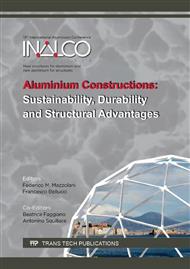[1]
H. Amini Mashhadi, A. Moloodi, M. Golestanipour, E.Z.V. Karimi (2009), Recycling of aluminium alloy turning scrap via cold pressing and melting with salt flux, Materials Processing Technology 209, 3138-3142.
DOI: 10.1016/j.jmatprotec.2008.07.020
Google Scholar
[2]
G.O. Verran, U. Kurzawa (2008), An experimental study of aluminum can recycling using fusion in induction furnace. Resources Conservation and Recycling, 52, pp.731-736.
DOI: 10.1016/j.resconrec.2007.10.001
Google Scholar
[3]
T. Tchotang (2013), Contribution au traitement de recyclage de l'aluminum de récupération au Cameroun, Thèse doctorale, Yaoundé, Université de Yaoundé I, 297 pages. (In French).
DOI: 10.56377/jsas.v2n1.2135
Google Scholar
[4]
Xiong, Bojun (2015), Optimization of Recycling Process Of Die Cast Aluminum A380 Machining Chips, PhD thesis, University of Windsor, ON, Canada, Electronic Theses & Dissertations. Paper 5320.
Google Scholar
[5]
J. Gronostajski, H. Marciniak, A. Matuszak (2000). New methods of aluminum and aluminum-alloy chips recycling, Materials Processing Technology, 106 (1), 34-39.
DOI: 10.1016/s0924-0136(00)00634-8
Google Scholar
[6]
J.B. Fogagnolo, E.M. Ruiz-Navas, M.A. Simon, M.A. Martinez (2003), Recycling of aluminium alloy and aluminium matrix composite chips by pressing and hot extrusion, Materials Processing Technology 143-144 (2003) 792-795.
DOI: 10.1016/s0924-0136(03)00380-7
Google Scholar
[7]
R. Chiba and M. Yoshimura (2015), Solid-state recycling of aluminium alloy swarf into c-channel by hot extrusion, Manufacturing Processes 17, 1-8.
DOI: 10.1016/j.jmapro.2014.10.002
Google Scholar
[8]
M.A. Lajis, S.S. Khamis and N.K. Yusuf (2014), Optimization of Hot Press Forging Parameters in Direct Recycling of Aluminium Chip (AA 6061), Key Engineering Materials V. 622-623, 223-230.
DOI: 10.4028/www.scientific.net/kem.622-623.223
Google Scholar
[9]
R. Chiba, T. Nakamura, M. Kuroda (2011), Solid-state recycling of aluminium alloy swarf through cold profile extrusion and cold rolling, Mat. Processing Technology 211, 1878-1887.
DOI: 10.1016/j.jmatprotec.2011.06.010
Google Scholar
[10]
T. Tokarski, M. Wędrychowicz and M. Wiewióra (2015), Light metals chips recycling by plastic consolidation, Key Engineering Materials V. 641, 24-29.
DOI: 10.4028/www.scientific.net/kem.641.24
Google Scholar
[11]
W. Chmura and J. Gronostajski (2000), Mechanical and tribological properties of aluminium-base composites produced by the recycling of chips; Materials Processing Tech., 106, 23-27.
DOI: 10.1016/s0924-0136(00)00632-4
Google Scholar
[12]
L.M.P. Ferreira, M.H. Robert, E. Bayraktar (2015), Production of Aluminum /SiC/NiAl2O4 MMCs By Thixoforming Of Recycled Chips, Solid State Phenomena V. 217-218, 286-293.
DOI: 10.4028/www.scientific.net/ssp.217-218.286
Google Scholar
[13]
P. Zapp, G. Rombach, W. Kuckshinrichs (2002), The future of automotive aluminum [C], TMS Annual Meeting, Seattle, 2002, 1003-1010.
Google Scholar
[14]
J.B. Mandatsy Moungomo, D. Nganga-Kouya, V. Songmene, J. Kouam & J.P. Kenné (2016) Machinability Study of Recycled Aluminum Cans and Machining Chips, Advanced Manufacturing Technology, on-line, April 4th 2016, DOI 10. 1007/s00170-016-8564-x.
DOI: 10.1007/s00170-016-8564-x
Google Scholar
[15]
A.E. Tekkaya, M. Schikorra, D. Becker, D. Biermann, N. Hammer, K. Pantke (2009) Hot profile extrusion of AA-6060 aluminum chips, Materials Processing Tech. 209, 3343-3350.
DOI: 10.1016/j.jmatprotec.2008.07.047
Google Scholar
[16]
J. Kouam, V. Songmene, Y. Zedan, A. Djebera and R. Khettabi (2013), On chip formation during drilling of cast aluminum alloys, Machining Science and Technology, 17, 228-245.
DOI: 10.1080/10910344.2013.780546
Google Scholar


